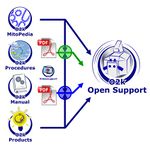|
|
| (One intermediate revision by the same user not shown) |
| Line 7: |
Line 7: |
| |year=2018-11-18 | | |year=2018-11-18 |
| |journal=Mitochondr Physiol Network | | |journal=Mitochondr Physiol Network |
| |abstract= Oroboros (2018) MitoPathways at the Q-junction: mouse skeletal muscle fibers. Mitochondr Physiol Network 12.01(03): Suppl T-issue. » [http://www.bioblast.at/index.php/File:MiPNet12.01 Versions] | | |abstract= Oroboros (2018) MitoPathways at the Q-junction: mouse skeletal muscle fibers. Mitochondr Physiol Network 12.01(03): Suppl T-issue. |
| {{MiPNet pdf page linking to MitoPedia}} | | {{MiPNet pdf page linking to MitoPedia}} |
|
| |
|
| Line 23: |
Line 23: |
| |additional=MitoPathways, O2k-Demo, O2k-Core | | |additional=MitoPathways, O2k-Demo, O2k-Core |
| }} | | }} |
|
| |
|
| |
| == Limitations of the SUIT protocol ==
| |
|
| |
| === Maximum OXPHOS and ET-capacity ===
| |
| :::: Evaluation of maximum respiratory capacities requires titration of further substrates activating additional [[respiratory complexes]] at the Q-junction ([[Electron-transferring flavoprotein complex |CETF]] and [[glycerophosphate dehydrogenase complex |CGpDH<]]).
| |
|
| |
| === Malate concentration ===
| |
| :::: The [[malate]] concentration was 2 mM, to saturate N-linked respiration. However, at 2 mM malate, the fumarate concentration is increased to a level which inhibits succinate dehydrogenase. Then NS- and S-linked respiratory capacities are underestimated. A malate concentration of 0.5 mM, which saturates N-linked respiration and inhibits S-linked respiration to a lesser extent, represents and improved standard.
| |
| ::::» [[Talk:Malate |Optimum malate concentration in SUIT protocols]]
| |
|
| |
| === ROX correction ===
| |
| :::: The fact that ROX was higher in the NS-substrate state compared to N-linked LEAK respiration indicates that ROX is partially controlled by the substrate state. Therefore, a single measurement of ROX cannot be applied for correction of total oxygen consumption in the different substrate states. Total respiration, therefore, represents apparent coupling states ''L''´, ''P''´ and ''E''´ (Fig. 1). ROX correction is possible in the present experiment only for NS- and S-linked respiration. [[Azide]] inhibits not only CIV but other heme-based oxidases and peroxidases, and therefore may interfere with ROX beyond blocking respiratory electron transfer. Based on this argument, a combination of CII- and CIII-inhibitors (malonic acid, antimycin A, myxothiazol) may yield more consistent results, although any ROS scavenged by cytochrome ''c'' may in the absence of a CIV-inhibitor result in respiratory oxygen consumption through CIV.
| |
Latest revision as of 12:30, 4 December 2019






MiPNet12.01 Suppl T-issue
| MitoPathways at the Q-junction: mouse skeletal muscle fibers.
|
»  »Versions
»Versions
Oroboros (2018-11-18) Mitochondr Physiol Network
Abstract: Oroboros (2018) MitoPathways at the Q-junction: mouse skeletal muscle fibers. Mitochondr Physiol Network 12.01(03): Suppl T-issue.
- Open the pdf document above.
• O2k-Network Lab: AT_Innsbruck_Oroboros
Labels: MiParea: Respiration
Organism: Mouse
Tissue;cell: Skeletal muscle
Preparation: Permeabilized tissue
Coupling state: LEAK, ROUTINE, ET
Pathway: N, S, NS, ROX
HRR: Oxygraph-2k, O2k-Protocol
MitoPathways, O2k-Demo, O2k-Core
![]() »Versions
»Versions







